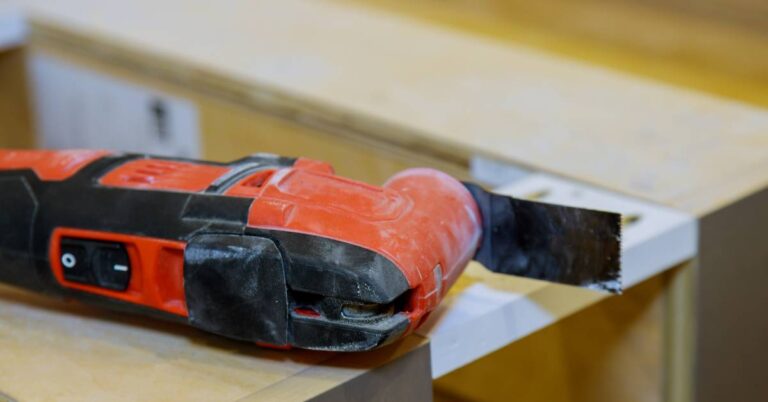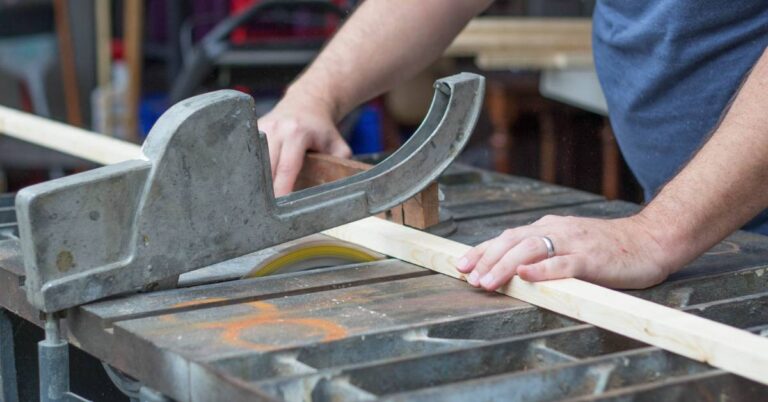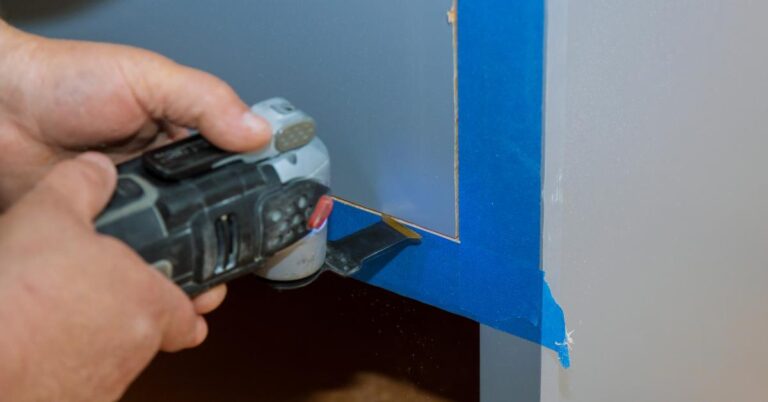jigsaw vs. Oscillating Tool: An In-Depth Guide to Master Your DIY Projects
Introduction to Jigsaw and Oscillating Tools
When tackling DIY projects, having the right tools can make all the difference.
Two power tools that often come into play are the jigsaw and the oscillating tool. These versatile devices can help you achieve precise cuts, make quick work of various materials, and enhance your overall efficiency in completing projects.
The jigsaw tool, also known as a sabre saw, is a handheld power tool that utilizes a reciprocating blade for cutting through different materials such as wood, plastic, metal, and even ceramic tiles. Its popularity stems from its ability to create curved cuts with ease and precision.
Whether you’re working on intricate woodworking projects or need to make curved cuts for decorative purposes, the jigsaw is an indispensable tool in any DIY enthusiast’s arsenal. On the other hand, oscillating tools have gained immense popularity for their versatility and ability to handle various tasks.
These handheld power tools utilize a rapid back-and-forth oscillating motion for various cutting operations. From sanding and scraping to plunge-cutting and grinding applications, oscillating tools have become a go-to choice for professionals and hobbyists.
You might be wondering which of these two powerhouses is better suited for your DIY endeavors. While both serve different purposes, they share some similarities in terms of functionality.
The jigsaw tool uses a reciprocating motion similar to a handsaw but offers greater control and precision due to its motorized operation. In contrast, an oscillating tool boasts multiple attachments that allow it to perform various tasks efficiently.
From sanding large surfaces with ease using sanding pads or removing grout from between tiles with specialized blades – an oscillating tool proves its worth time and time again when it comes to versatility. To determine whether an oscillating tool or a jigsaw would be the better choice for your specific needs, it’s crucial to understand their respective capabilities and applications.
This comprehensive guide will delve into these tools’ intricacies, providing valuable insights to help you make an informed decision. So, let’s dive in and explore the world of jigsaws and oscillating tools, unlocking their potential for your DIY projects.
Understanding the Functionality of Jigsaw Tools
When tackling various DIY projects, one tool that consistently proves its usefulness is the jigsaw.
With its unique functionality and versatility, the jigsaw has become a staple in the arsenal of many DIY enthusiasts and professional craftsmen. Let’s dive into the inner workings of this remarkable power tool.
Jigsaws are primarily designed for making intricate curved cuts, but they can also easily handle straight cuts. Their thin reciprocating blades move up and down, enabling them to navigate tight corners and curves effortlessly.
This feature makes them ideal for cutting out patterns or creating decorative designs on woodwork. One of the advantages of jigsaws is their ability to accept various blade types, allowing you to adapt your tool to different materials and cutting needs.
From blades specifically designed for wood to those suitable for metal or plastic, a wide range of options are available. This versatility enables you to tackle many projects without needing multiple tools.
Using a jigsaw requires some finesse and skill. It’s essential to hold the tool steady while guiding it along your desired path to make precise cuts.
Adjusting the speed settings according to your material can enhance accuracy and efficiency. By mastering these techniques, you’ll be able to achieve clean lines and smooth edges on your projects.
Utilizing a jigsaw with a fine-toothed blade is highly recommended for woodworking enthusiasts seeking precision cuts without splintering or tear-out on delicate materials like plywood or veneer. Jigsaws excel in tasks that require detailed work, such as creating intricate puzzle pieces or shaping wooden crafts.
Unlike oscillating tools, which we’ll explore later in this guide, jigsaws are tailored explicitly for cutting tasks rather than general-purpose applications. While they excel at what they do best—curved and intricate cuts—they may not be as efficient when sanding, scraping, or other tasks that require a more versatile tool.
Jigsaws are a must-have for anyone looking to master the art of detailed and curved cuts. Their ability to adapt to various materials and blade types provides a wide range of possibilities for creative woodworking projects.
However, an oscillating tool might be worth considering if you’re aiming for a multipurpose tool that can go beyond cutting. In the next section, we will explore the versatility and applications of oscillating tools in detail.
Exploring the Versatility of Oscillating Tools
When it comes to versatility in DIY projects, oscillating tools genuinely shine. These handy power tools are known for their ability to tackle a wide range of tasks, making them a valuable addition to any toolbox.
From sanding and scraping to cutting and grinding, an oscillating tool can easily handle it all. One of the critical advantages of oscillating tools is their ability to access tight or hard-to-reach areas.
Unlike jigsaws with fixed blades that move up and down, oscillating tools feature a small head that vibrates side to side at high speeds. This unique motion allows you to navigate corners, edges, and other confined spaces with precision and control.
Another area where these versatile tools excel is their ability to perform intricate detail work. The proper attachment or accessory can transform an oscillating tool into a multi-functional powerhouse.
Need to remove grout between tiles? Attach a grout removal blade.
Want to trim baseboards or door casings? Swap in a flush-cutting blade.
The possibilities are endless. Oscillating tools also offer great flexibility when it comes to materials.
Whether working with wood, metal, plastic, or even drywall, these tools can adapt effortlessly by changing the blade type or attachment. From cutting through pipes and nails to sanding rough surfaces smooth, there’s almost no limit to what an oscillating tool can do.
When comparing the versatility of jigsaws versus oscillating tools for DIY projects, the latter comes out on top due to its adaptability and functionality in various tasks. Whether tackling woodworking projects or home repairs around the house, investing in an oscillating tool will provide endless possibilities for getting the job done efficiently and effectively.
Comparative Analysis: Power and Performance
Regarding power and performance, both the jigsaw and oscillating tools have unique qualities that make them suitable for different DIY projects. Let’s delve into a comparative analysis to understand how these tools stack against each other. The jigsaw tool’s power primarily lies in its ability to make precise cuts in various materials such as wood, metal, and plastic.
A jigsaw can effortlessly navigate curves and intricate designs with the correct blade type and cutting technique. Whether crafting wooden furniture or shaping foam for upholstery, the jigsaw tool proves its worth in woodworking projects.
On the other hand, oscillating tools excel in versatility thanks to their wide range of attachments. These multi-function oscillating tools offer many applications for your DIY needs, from sanding pads and cutting blades to scrapers and grout removers.
Need to remove grout from your bathroom tiles? No problem – attach a carbide blade to your oscillating tool and watch it effortlessly scrape away the unwanted material.
Regarding power output, both tools are highly efficient but with different focuses. Jigsaws typically have higher wattage motors, providing them with more cutting power than oscillating tools.
This makes them ideal for heavier-duty tasks like ripping through thick boards or making long, straight cuts. On the other hand, while oscillating tools may have slightly lower wattage motors, they compensate with high-speed vibrations that allow them to excel at detail work, such as plunge-cutting into tight corners or trimming excess material.
However, it is essential to note that jigsaws tend to outperform oscillating tools due to their faster reciprocating action when it comes to pure cutting speed. So, if you’re working on time-sensitive projects where speed is crucial – like installing laminate flooring or cutting large sections of plywood – then choosing a jigsaw might be the better option.
When considering power and performance, it’s essential to evaluate the specific requirements of your DIY project. A jigsaw will be your go-to tool if you’re primarily focused on precision cutting and intricate designs.
However, if versatility and adaptability are what you seek, an oscillating tool with its wide range of attachments might be the perfect fit. Ultimately, choosing between a jigsaw and an oscillating tool for your DIY projects boils down to understanding their capabilities and selecting the right tool for the job.
Versatility: Which Tool Offers More Functionality?
Regarding versatility, both jigsaws and oscillating tools have their own unique set of benefits. Choosing the right tool for your project ultimately depends on the specific tasks you need to accomplish.
Let’s start by exploring the versatility of jigsaw tools. Jigsaws are renowned for their ability to cut intricate shapes and curves in various materials.
With different blade types available, such as fine-toothed blades for wood and metal-cutting blades for more rigid materials, jigsaws provide flexibility in tackling a wide range of projects. Whether working on woodworking projects or making precise cuts for home repairs, a jigsaw can be your go-to tool.
On the other hand, oscillating tools offer a distinct level of functionality that sets them apart from jigsaws. These multi-function powerhouses can easily handle various tasks, including cutting, sanding, scraping, and grinding.
Switching out different attachments makes an oscillating tool incredibly versatile in tackling diverse applications. From trimming baseboards and removing grout to sanding tight corners or even plunge-cutting into walls for electrical work – an oscillating tool proves its worth as a jack-of-all-trades.
While both tools shine in their respective areas of expertise, it’s essential to consider which offers more functionality for your specific needs. Suppose your projects involve predominantly straight-line cuts or delicate curves in wood or metal. In that case, a jigsaw may be the ideal choice due to its precision cutting capabilities with specialized blades.
However, you require a tool that can handle cutting, sanding, scraping, and grinding tasks across materials like wood, drywall, or tile. In that case, an oscillating tool is likely the way to go. Its versatility allows you to tackle multiple jobs without switching between power tools.
Ultimately, deciding between an oscillating tool and a jigsaw based on versatility alone comes down to the nature of your projects and the range of tasks you expect to handle. By evaluating your specific needs and understanding the capabilities of each tool, you can make an informed decision that ensures maximum functionality and efficiency for your DIY endeavors.
Ease of Use: Jigsaw vs. Oscillating Tool
When it comes to ease of use, both jigsaws and oscillating tools have their unique advantages. Let’s take a closer look at each tool and the factors that contribute to their usability.
Starting with jigsaws, they are generally considered user-friendly, especially for beginners. Many manufacturers offer models specifically designed for newcomers to the DIY world.
These beginner-friendly jigsaws often come with features like adjustable speed settings and ergonomic grips, making them comfortable to hold and control during operation. If you’re starting with power tools, investing in the best jigsaw for beginners can be a wise choice.
Understanding the capabilities of a jigsaw is crucial in maximizing its ease of use. Jigsaws are versatile cutting tools that handle various materials such as wood, plastic, metal, and even ceramic tiles.
Additionally, they come with different blade types that cater to specific applications. For example, T-shank blades are ideal for straight cuts, while scrolling blades allow for intricate curves.
Being familiar with these blade options will make your projects easier and enhance your overall cutting precision. On the other hand, oscillating tools offer considerable ease of use due to their lightweight design and compact size.
They are incredibly maneuverable and allow users to easily access tight corners and awkward angles – something that may prove challenging for more extensive power tools like jigsaws or circular saws. Oscillating tools come with various attachments or accessories that enhance their versatility and ease of use.
These multi-function oscillating tools can handle tasks beyond cutting, from sanding pads to scraping blades and even grout removal attachments. Swapping out attachments as needed allows you to seamlessly transition from one job to another without switching between different power tools.
Regarding the learning curve, oscillating tools are relatively easy to grasp compared to jigsaws. They move back and forth rapidly rather than rotating like jigsaws, making them more forgiving in cutting accuracy.
However, it’s important to note that safety measures for using oscillating tools should still be followed diligently to avoid any accidents or injuries. Ultimately, when considering ease of use between a jigsaw and an oscillating tool for your DIY projects, it depends on the nature of the tasks you plan to undertake.
A jigsaw may be the better option if you primarily work with materials that require precise cutting and shaping, such as woodworking projects. On the other hand, if you’re looking for a versatile tool that can handle multiple applications and provide easy access to tight spaces, an oscillating tool might suit your needs better.
Consider your skill level and project requirements when choosing between these power tools. With practice and experience, both jigsaws and oscillating tools can become valuable assets as you embark on various DIY endeavors.
Cost Comparison: Making the Most of Your Investment
Regarding power tools, it’s essential to consider the cost and make the most out of your investment. Both jigsaws and oscillating tools have their price points, so let’s dive into the cost comparison and see which tool offers more value for your money. Jigsaws are known for being more budget-friendly compared to oscillating tools.
Their prices can vary depending on factors such as brand, features, and additional accessories included. For beginners on a tight budget, plenty of affordable options are available that still deliver decent performance.
Look out for jigsaw models that balance price and quality, ensuring you maintain functionality. On the other hand, oscillating tools tend to be slightly pricier than jigsaws.
However, they often come with various attachments and accessories that justify their higher cost. These multi-function tools can tackle multiple tasks beyond just cutting.
With interchangeable blades and sanding attachments, an oscillating tool becomes an all-around performer in your DIY arsenal. So, while you may be paying more upfront for an oscillating tool, its versatility can make it a worthwhile investment in the long run.
When comparing costs between jigsaws and oscillating tools, it’s essential to consider your specific project needs. Investing in a high-quality jigsaw would be wise if you primarily work on woodworking projects requiring precise cuts or intricate curves.
Look for jigsaw models designed explicitly for woodworking purposes – they often come with additional features like variable speed controls or orbital action settings that enhance their cutting capabilities. However, suppose you love taking on various DIY projects around the house that involve cutting, sanding, or scraping surfaces. In that case, an oscillating tool might be a better choice despite its slightly higher price tag.
The ability to switch between different attachments allows you to tackle various tasks without having to invest in separate tools. While jigsaws may have a lower initial cost, oscillating tools offer more versatility and functionality.
Consider the nature of your projects, your budget, and the range of tasks you anticipate undertaking. Choosing the right tool for your DIY endeavors will ensure that you make a cost-effective investment that caters to all your needs.
Jigsaw and Oscillating Tool Safety Precautions
Safety should always be the top priority when it comes to using power tools like jigsaws and oscillating tools. These tools may provide immense versatility and capability but can pose risks if handled inappropriately.
Whether you are a seasoned DIY enthusiast or just starting, following some essential safety precautions is crucial to ensure a smooth and accident-free experience. One fundamental safety aspect of an oscillating tool is wearing protective gear.
This includes goggles or safety glasses to shield your eyes from flying debris, especially when working with wood or metal that may produce splinters or sparks. Additionally, wearing ear protection can help mitigate the noise generated by these powerful tools.
Another essential safety measure is ensuring a stable work surface. When using an oscillating tool, secure your workpiece firmly in place using clamps or vices to prevent it from wobbling or moving unexpectedly during operation.
This stability will lead to more accurate cuts and reduce the risk of accidents caused by slipping materials. Moreover, understanding the limitations of your oscillating tool attachments is crucial for safe usage.
Attachments are designed for specific applications such as plunge cutting, sanding, or scraping. Refer to the manufacturer’s instructions and select the appropriate attachment for your desired task.
Using correct attachments can result in good performance. Maintaining proper hand placement is vital when operating an oscillating tool.
Keep both hands on the tool’s handles for maximum control and stability. Avoid placing your fingers near the blade during operation, as accidental contact can cause severe injuries.
Similarly, jigsaw tools require specific safety measures to ensure safe operation. One important consideration is selecting the right jigsaw blade type for your project requirements—different blades are designed for cutting various materials such as wood, metal, plastic, or ceramic tiles.
Choosing an inappropriate blade can lead to inefficient cuts and potential hazards. Additionally, when using a jigsaw, it is essential to secure your workpiece correctly.
Using clamps or other suitable means of fixation will prevent the material from moving or vibrating excessively during cutting, minimizing the risk of accidents. Furthermore, it is crucial to practice proper cutting techniques with a jigsaw.
Maintaining a steady hand and following marked lines accurately will result in precise cuts and reduce the chances of unexpected deviations that could cause mishaps. Remember to wear protective gear when operating a jigsaw.
Safety glasses are essential to shield your eyes from debris generated during cutting. Additionally, wearing a dust mask may be necessary to avoid inhaling harmful particles depending on the material being cut.
Whether using an oscillating tool or a jigsaw for your DIY projects, taking necessary safety precautions is crucial for a successful and accident-free experience. Always wear appropriate gear, such as goggles and ear protection, to ensure stable work surfaces and adequately secure your materials.
Familiarize yourself with using different attachments or blade types correctly, and always maintain proper hand placement. By diligently following these safety measures, you can enjoy the versatility and capabilities offered by these power tools while protecting yourself from potential hazards.
Recommendations for Beginners
Regarding recommendations for beginners, both jigsaws and oscillating tools have their strengths and ultimately depend on the specific project at hand. If you’re new to power tools, a jigsaw can be a great starting point.
Its simplicity and ease of use make it an ideal choice for those dipping their toes into the DIY realm. Look for a jigsaw that is lightweight, has variable speed settings, and comes with a straightforward user manual.
One of the advantages of oscillating tools is their versatility, making them suitable for various DIY projects. However, they can be slightly more complex to operate compared to jigsaws.
Investing in a multi-function oscillating tool might be worth considering for beginners who want an all-in-one tool that can handle multiple tasks like sanding, cutting, and scraping with precision. Browse through models that offer interchangeable attachments for maximum flexibility.
A jigsaw is often the preferred choice for those primarily interested in woodworking projects or intricate cuts in materials like lumber or plywood. It allows you to make curved cuts effortlessly with its up-and-down blade motion.
Look for a jigsaw designed explicitly for woodworking tasks, as they typically offer features such as adjustable base plates for bevel cuts and orbital action settings for faster cutting speeds. On the other hand, if you plan on tackling various DIY projects beyond woodworking – such as plumbing repairs or home renovation tasks – an oscillating tool might be more suitable due to its wide range of applications.
These multipurpose tools excel at detailed work in tight spaces where other power tools may struggle to maneuver. Safety should always be paramount whether you choose a jigsaw or an oscillating tool as your starting point.
Familiarize yourself with safety measures specific to each tool—such as wearing protective goggles and gloves—and take time to understand the capabilities and limitations of your chosen device. Both jigsaws and oscillating tools have unique benefits and applications, making them valuable additions to any DIY enthusiast’s toolbox.
A jigsaw may be the perfect starting point if you’re a beginner looking for simplicity and versatility. However, if you desire an all-in-one tool that can handle a broader range of projects, an oscillating tool could be a wise investment.
Consider the nature of your projects and choose accordingly, always keeping safety in mind. Happy DIYing!
The Final Verdict: Which Tool Should You Choose?
When choosing between a jigsaw and an oscillating tool for your DIY projects, there are a few key factors to consider. Both tools have unique features and applications, so it’s essential to understand your specific needs and the nature of your projects before deciding. If you’re primarily looking for a tool that offers versatility and the ability to tackle various tasks, then an oscillating tool might be the way to go.
One of the most significant advantages of an oscillating tool is its wide range of attachments, which allows you to easily sand, scrape, cut, grind, and even polish different materials. This multi-function tool can handle everything from removing grout in bathroom tiles to cutting through metal pipes or scraping paint off wooden surfaces.
On the other hand, if precision cutting is your main requirement, then a jigsaw could be your best bet. Jigsaws are specifically designed for making curved cuts in wood or other materials.
With adjustable speed settings and various blade options like straight-cut blades or scroll-cut blades, they offer great flexibility in cutting techniques. Whether you’re working on a woodworking project requiring intricate detailing or making clean, straight cuts in plywood for home repairs, a jigsaw can be an invaluable companion.
While both tools have their strengths and applications depending on the project at hand, it’s worth noting that jigsaws are generally more user-friendly for beginners due to their straightforward operation. They offer better visibility during cutting thanks to their up-and-down motion compared to the back-and-forth movement of an oscillating tool.
Furthermore, jigsaws have ergonomically designed handles that provide better control and comfort. However, budget-consciousness plays into your decision-making process; it’s worth noting that jigsaws generally cost less than multi-function oscillating tools.
While both tools are cost-effective power tools compared to more significant equipment like table saws or miter saws, investing in a good-quality jigsaw can be an excellent starting point for beginners. There are plenty of reliable options available that provide adequate power, adjustable speed settings, and compatibility with various blade types.
Choosing between a jigsaw and an oscillating tool ultimately depends on the specific needs of your DIY projects. If versatility and multi-functionality are your top priorities, then an oscillating tool with its range of attachments is the way to go.
However, if you require precise cutting ability and ease of use, a jigsaw might suit your needs. Assess your project requirements, consider the features and advantages of each tool discussed here, and make an informed decision based on what will best serve your DIY endeavors.
Conclusion
When it comes to choosing between a jigsaw and an oscillating tool for your DIY projects, it ultimately depends on the specific tasks you need to accomplish. Both tools have their unique advantages and applications. The jigsaw is an excellent choice if you’re primarily working with wood and need precise, intricate cuts.
Its ability to make curved cuts and its wide selection of blade types make it indispensable for woodworking projects. Additionally, jigsaws offer more power and cutting depth than oscillating tools, making them ideal for thicker materials.
On the other hand, an oscillating tool is a fantastic option if you’re looking for a versatile tool that can handle various tasks such as sanding, grinding, scraping, or plunge cutting in different materials such as metal or drywall. With its vast array of attachments and accessories available on the market, an oscillating tool can be adapted to almost any job.
Both tools have their strengths in terms of ease of use. Jigsaws offer better maneuverability due to their lightweight design and ergonomic handles.
However, oscillating tools are also relatively easy to handle and control thanks to their compact size and multiple grip options. Regarding cost-effectiveness, both jigsaws and oscillating tools come at various prices depending on the brand reputation and features offered.
It’s essential to consider your budget and the long-term investment value these power tools provide for your future DIY endeavors. Ultimately, whether you choose a jigsaw or an oscillating tool depends on the nature of your project requirements.
If woodworking is your primary focus or requires precise cutouts in materials like plywood or laminate flooring tiles, a good quality jigsaw will serve you well. However, if versatility across different materials is what you seek or if you plan on tackling various home repair tasks beyond just cutting jobs alone – then investing in an oscillating tool would be ideal.
Regardless of your choice, always prioritize safety measures when using power tools. Familiarize yourself with proper handling techniques, wear appropriate safety gear, and diligently follow the manufacturer’s instructions to ensure a safe and enjoyable DIY experience.
Embrace the power of these essential tools for home repair, unleash your creativity with their applications, and confidently tackle your DIY projects, knowing you have chosen the right tool for the job. Happy crafting!




